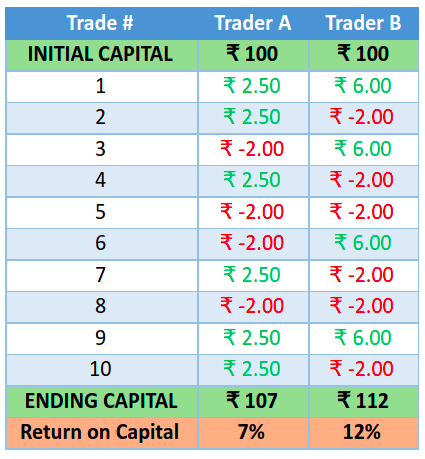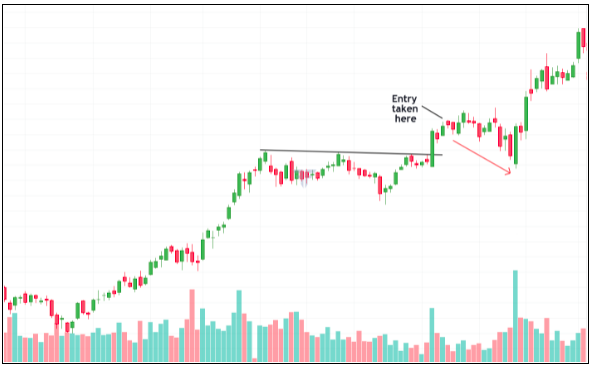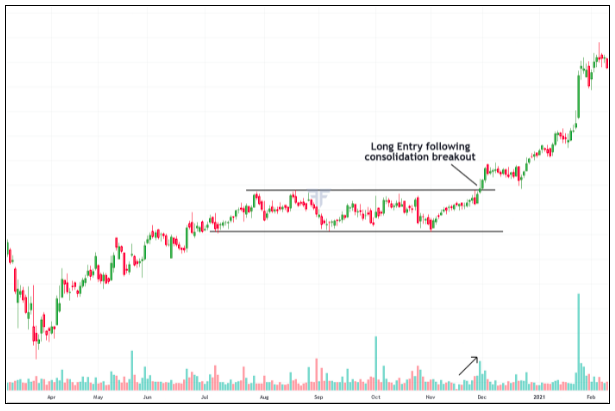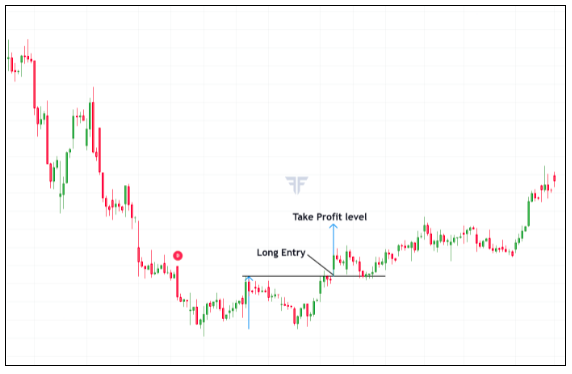
Now that we have discussed the basics of trading, it is time to move ahead and talk about some critical aspects of risk management in trading. In this chapter, we will focus on entry, target, and the reward to risk ratio.
Basic terminologies to be aware of:
Before we proceed towards discussing the main part of this chapter, let us quickly talk about a few basic, yet critical concepts:
-
Entry price: This is the price at which a security is bought or sold short
-
Exit price: This is the price at which an existing long or short position is closed
-
Short Sell: This refers to selling a security without even owning it, with the intent of buying back later at a lower price
-
Stop loss: This is the price at which a loss-making position would be exited. At the time of entering a position, you must know what the stop loss for the trade should be
-
Target: This is the price at which a profit-making position would be closed. At the time of entering a position, you must decide what the target for the trade should be
-
Trailing Stop Loss: This means revising the stop loss in the direction of the trade when it is comfortably profitable. Stop loss should never be revised against the direction of the trade
-
Reward to Risk ratio: This measures the reward per unit of risk. It can either be expressed as a single number or as a ratio
-
Position Sizing: This refers to determining the size of each position on the basis of factors such as risk tolerance level, reward expectations, capital deployed, conviction etc.
We will talk about each of these aspects in detail over the course of this and the next few chapters.
When it comes to trading, Technical Analysis (TA) can offer immense utility. It can help in identifying several critical aspects concerning the risk management side of a trade such as the entry level, the take profit level, the stop loss, the reward to risk ratio etc. Furthermore, by helping to identify charting aspects such as the price trend of a security, price patterns, volume behaviour, support and resistance etc., TA can also help in deciding the type of trades to be initiated (long or short). Hence, if you do not know TA, we would highly suggest you go through the Technical Analysis module on School of Stocks, by clicking here We have covered its various aspects in great detail. For our discussion going forward in this chapter and the next, we will focus quite extensively on TA. As such, it would be assumed that the reader understands various aspects of TA.
How much capital to allocate for trading?
We already spoke extensively about this in the previous chapter. However, what we spoke back then was primarily concerned with the capital required to trade in the cash market. What about the capital requirement if one wants to trade futures or write options? Well, because exchanged-traded derivatives are standardized contracts, the capital required can vary depending on the securities you trade. As an example, you will be able to trade multiple stocks in the cash market even with a capital of ₹1 lac or less. However, with such a capital, it will not be possible to execute naked long/short positions in equity/index futures or naked short positions in equity/index options and carry them overnight (As things stand, from 1st September 2021, as per the SEBI’s peak margin requirements, it will not be possible to create even intraday positions with such capital, as 100% of initial margin would be required upfront, to create naked long/short futures and naked short options positions).
As an example, as at the time of writing, the stock futures that requires the lowest overnight margin is Colgate Palmolive (COLPAL), at ~₹1.06 lacs per lot. On the other hand, the stock futures that requires the highest overnight margin is CoForge, at ~₹6.55 lacs per lot. Meanwhile, Nifty and Bank Nifty require an overnight margin of ~₹1.79 lacs and ~₹1.75 lacs, respectively. As such, if you are primarily trading naked futures or writing naked options, it would be preferable to trade with a capital of at least ₹8-10 lacs (although this can vary from one trader to another). The higher the capital, the better. On the other hand, if you are primarily trading hedged strategies, such as a Protected Put, Condor, Butterfly etc., you could start with a much lower capital. This is because unlike a naked long/short futures or short options, hedged strategies tend to be much safer and as a result, have much lower margin requirements. To check how much margin is needed for hedged strategies, visit our FYERS margin calculator page by clicking the link here.
In short, depending on the instrument (cash, derivatives, or both), securities (equities, commodities, currencies, or a combination), and the trading size (quantity), the capital required can vary. As a thumb rule, it is advisable to trade with sufficient capital rather than a bare minimum capital, so as to be able to navigate through periods of losses.
Defining Reward to Risk Ratio per trade:
Defining Reward to Risk Ratio (RRR) is an extremely critical component of trading. Depending on your trading style, RRR can vary. For instance, a scalper might prefer trading with an RRR that is closer to 1, a day trader might prefer trading with an RRR of 1.5, a positional trader might prefer trading with an RRR of 3, etc. As you can see, the RRR typically varies with the time horizon of a trade – the smaller the time horizon, the smaller the RRR tends to be, and vice versa. As a general rule, if you are trading cash or futures or buying options, the RRR must be favourable before entering a trade. If not, the trade may not be worth entering into. One exception to this is when you are writing options or deploying multi-legged option strategies. In such a case, an RRR less than 1 could be acceptable if the probability of profit is in your favour.
Let us now understand how to calculate the RRR. Let us assume that you have spotted a potential buying opportunity at ₹100, with a stop loss at ₹97, and a target of ₹105. In this case,
- Potential reward = ₹105-₹100 = ₹5
- Potential risk = ₹100-₹97 = ₹3
- So, RRR = Reward/Risk= 53=1.67
What this tells us is that for a risk of 1 unit, the reward is 1.67 units.
Similarly, let us assume that you have spotted a potential shorting opportunity at ₹100, with a stop loss at ₹102, and a target of ₹95. In this case,
- Potential reward = ₹100-₹95 = ₹5
- Potential risk = ₹102-₹100 = ₹2
- So, RRR = Reward/Risk= 52=2.5
What this tells us is that for a risk of 1 unit, the reward is 2.5 units.
As said earlier, it is important to have a favourable RRR. Let us now try to understand why. Let us assume that following:
- Trader A is trading with an RRR of 1.25
- Trader B is trading with an RRR of 3
- Both have taken a total of 10 trades
- Both started with a capital of ₹100
- Trader A: Risk per trade = ₹2, Reward per trade = ₹2.5
- Trader B: Risk per trade = ₹2, Reward per trade = ₹6
Based on this, let us now see how the two have fared:

It can be seen that both have earned a profit. It can also be seen that A had a winning rate of 60% (6 out of 10 trades were profitable), while B had a winning rate of just 40% (only 4 out of 10 trades were profitable). However, despite having a lower winning rate than A and despite having more loss-making trades than profitable trades, see that B earned a greater profit in absolute terms and a higher return on capital deployed. The reason for this is because B had a much better RRR than A. As can be seen, if the RRR is favourable, you can earn good profits even with a low winning rate.
That said, when it comes to RRR, the context also matters. For instance, a scalper might not be able to trade with an RRR of, say, 2, because his/her holding period is just a few seconds/minutes and risk per trade tends to be just a few ticks. With such a short time span and small risk per trade, it would be difficult to earn profits with such an RRR. Similarly, it might not be possible for a day trader to trade with an RRR of, say, 3, if the stop loss is, say, 0.5% from the entry level and the average daily price move is 0.8%. Remember, the objective of a day trader is to enter and exit on the same day. On the other hand, a positional trader, can trade with an RRR of, say, 3 or even higher. This is because a positional trader has no restriction on the holding period and can hold the security for several days, until one of stop loss is hit or target is achieved. Hence, when determining RRR, the overall context must be taken into consideration.
Determining Entry levels:
Once a trading opportunity has been identified (long or short), you must decide on the entry level, that is the price at which you would be willing to enter a position. When it comes to trading, it is important to time the entry level well rather than entering a trade at any random price level. This is especially true when taking positions in leveraged instruments, such as derivatives. Keep in mind that even if your view turns out to be right, wrong timing could prevent you from reaping the rewards as you could be forced to exit the trade beforehand. To understand this, look at the chart below:

After consolidating for several candles, see that the security broke higher with a notable uptick in volume. However, what if instead of entering at the breakout level, a trader enters on the third candle following the breakout candle and places a stop loss right below the low of the breakout candle? Well, in that case, the position would have been stopped out, forcing the trader to exit the trade. Eventually, see that the view turned out to be right as the security, after a minor blip, did end up moving higher. However, despite getting the view right, the trader was unable to reap the benefit as his/her timing was wrong. Hence, timing the entry right is critical, especially when you are trading with a smaller stop loss.
Entry levels could be based on various parameters. We shall focus primarily on technical parameters here. Some of the key technical parameters on which an entry level could be based upon include:
- Prior lows (Support) and highs (Resistance)
- Price/pattern breakouts
- Key Fibonacci retracement levels
- Trend lines and channels
- Moving averages etc…

The chart above shows a consolidation breakout accompanied by an expansion in volume, signalling a good level to enter a long position in the security.
Determining Take Profit levels:
At the time of entering a position, a trader must also fixate on the exit strategy. Exit strategy involves determining two things: a stop loss and a take profit level. In this section, we will talk about the latter. Also known as the target, the take profit level is the level at which you would like to exit your position and book profits on a trade. Just like the entry price, the target price should also be based on a certain set of parameters, one of which are technical parameters. Some of the key technical parameters on which a take profit level could be based upon include:
- Prior support and resistance
- Near the price objective of chart patterns
- Near key Fibonacci extension levels
- Horizontal and Vertical Point and Figure counts etc…

The chart above shows a breakout from a Double Bottom chart pattern. For a long position initiated at breakout, one possible target would be the price objective of the pattern, which is equivalent to the height of the pattern (neckline - bottom) added to the breakout point.
Apart from being based on absolute values, take profit levels could also be percentage-based. For instance, at the time of entering, say, a short trade, you could decide to keep a target of, say, 10% below the entry level.
That said, keep in mind that the take profit level will also be influenced by the magnitude of the stop loss you set. For instance, if you decided to keep a stop loss that is 5 points away from the entry level, the take profit look level should ideally be more than 5 points (the higher above 5 points, the better). As said earlier, the RRR must be favourable when entering a trading position. Unless the probability of profit is pretty much in your favour (such as in case of some option strategies) rather than being 50-50 at initiation, it would not make much sense to have a higher risk per trade than reward.
In the next chapter, we will primarily focus on stop losses and their various aspects.
Next Chapter
Comments & Discussions in
FYERS Community